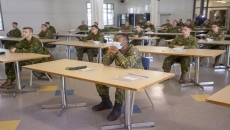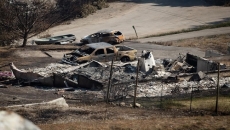A subvariant of the Omicron COVID-19 strain that has been circulating across the world appears to be picking up steam in some countries just as their latest waves of viral activity subside.
BA.2 was detected in Canada as early as December, according to Health Canada data, but a report last week from the B.C. COVID-19 modelling group suggests the newer Omicron strain could be spreading faster in parts of the country than the current dominant version, BA.1.
Data is limited across Canada, however, said co-author of the report Sarah Otto. Places like Alberta, where BA.2 accounted for 35 per cent of new infections last week, could be seeing inflated numbers from samples that were pre-screened for the subvariant before they were further analyzed, she added.
Experts say it's unclear whether a rise in BA.2 will threaten reopening plans as provinces lift restrictions and nix vaccine passports. But the timing could complicate things if the subvariant were to cause more severe disease than other Omicron strains, or if protection from vaccines and infections began to wane significantly.
Here's what we know about the latest COVID-19 subvariant.
WHAT MAKES BA.2 DIFFERENT FROM OTHER OMICRON STRAINS?
The World Health Organization says BA.2 has genetic variations that separate it from the Omicron variant first detected in November, including changes to the spike and other proteins.
Some researchers, including a group in Japan that studied the subvariant's effect on hamsters, proposed in a pre-print paper this month that the variations are stark enough that BA.2 "should be given a letter of the Greek alphabet and be distinguished from BA.1."
The WHO released a statement Tuesday saying while BA.2 is a "distinct sublineage of Omicron," it should continue to be considered a variant of concern and remain classified as Omicron.
Otto, an evolutionary virologist and mathematical modeller with the University of British Columbia, said the different Omicron strains are interesting, because "they share a lot of the same features, but not all of them."
"It's actually been a bit of a puzzle what they do differently," Otto said.
IS BA.2 MORE TRANSMISSIBLE?
The WHO says genetic differences between the two strains could be causing "a growth advantage" for BA.2, with initial data suggesting it's "inherently more transmissible than BA.1." The difference in contagiousness looks to be less drastic than the jump in transmissibility seen from Delta to BA.1, however.
The agency adds on its website that while BA.2 cases are increasing in proportion to other Omicron lineages, "there is still a reported decline in overall cases globally."
DOES BA.2 CAUSE MORE SEVERE DISEASE?
A pre-print, non peer-reviewed study published out of South Africa last week suggested the odds of being hospitalized with BA.2 versus BA.1 didn't differ, noting that "while BA.2 may have a competitive advantage over BA.1 in some settings, the clinical profile of illness remains similar."
Experts have noted, however, that South Africa has a younger population than Canada, and likely has a higher level of immunity from past infections.
The WHO says real-world data, including from South Africa but also from the United Kingdom and Denmark — other areas where immunity from vaccination or natural infection is high — have seen "no reported difference in severity between BA.2 and BA.1."
The original Omicron variant has been described as less severe than Delta, but experts have also said it's still a more virulent form than the first SARS-CoV-2 strain of early 2020.
Those who are unvaccinated remain at greater risk for hospitalization with any COVID-19 variant, they say.
The preliminary lab research from Japan that studied BA.2 in hamsters suggested the new subvariant may cause more severe disease compared to BA.1 in those who don't have any immunity.
WHAT'S THE RISK OF REINFECTION WITH BA.2?
Initial data suggests that previous Omicron infections provide strong protection against BA.2 "at least for the limited period for which data are available," the WHO says.
That could lessen the impact of potential BA.2 waves in places that saw large numbers of Omicron activity over the last several weeks.
Ontario's Science Advisory Table recently estimated that as many as four million people in the province were infected with Omicron from December through January.
Otto said that could explain why certain jurisdictions aren't seeing "a tidal wave of new BA.2 infections."
"(BA.2) is not immunologically distinct enough to kind of sweep through a population that recently had BA.1," she said.
Otto expects that most of Canada is already seeing declines in all Omicron activity, including BA.2 cases.
Vaccines have continued to provide excellent protection against severe disease and death with Omicron, even while protection against infection has dropped.
But those without immunity, including children not yet old enough to be vaccinated and immunocompromised people who don't build robust responses to vaccines, remain vulnerable.
"If they're exposed to something that's even more infectious, they're more likely to pick it up," said Dr. Anna Banerji, an infectious disease pediatrics expert with the University of Toronto.
"But a lot of people already are immune.... So infection may spread, but if it's not any more severe than the original Omicron, I'm not sure if it's going to make that much of a difference."
HOW DO WE KNOW HOW PREVALENT BA.2 IS IN CANADA?
Scientists use genomic sequencing, a painstaking process whereby a percentage of random viral samples from PCR tests are analyzed gene by gene, to determine which variants are circulating in the community.
Genomic sequencing has occurred through much of the pandemic, but with provinces limiting PCR testing criteria during the Omicron wave, Otto said it's harder to get an accurate picture of what's going on.
Adding to the challenge is a delay in sharing data from some jurisdictions, she said.
"I actually can't tell you what's happening in Manitoba or in Quebec because the publicly shared data hasn't been updated — that's a big problem," Otto said, adding that even in provinces where data is available, lack of testing means sequences are mostly coming from hospitalized cases or long-term care homes — "and that's not a random sample."
"Still," Otto said, "if we're seeing BA.2 rising in frequency in those populations, it's probably because it's rising in frequency in the community."
Experts say it's hard to predict how the BA.2 situation will unfold. But with restrictions lifting and immunity possibly waning in the months following infection or vaccination, provinces could see an extended fifth wave, or smaller wavelets of activity popping up.
"We're going to have to just track the data as best we can, track the hospitalizations, track cases among 70-plus (year-old) individuals because they tend to be well-tested," Otto said. "And if there's sign of a surge, sound the alarm."






